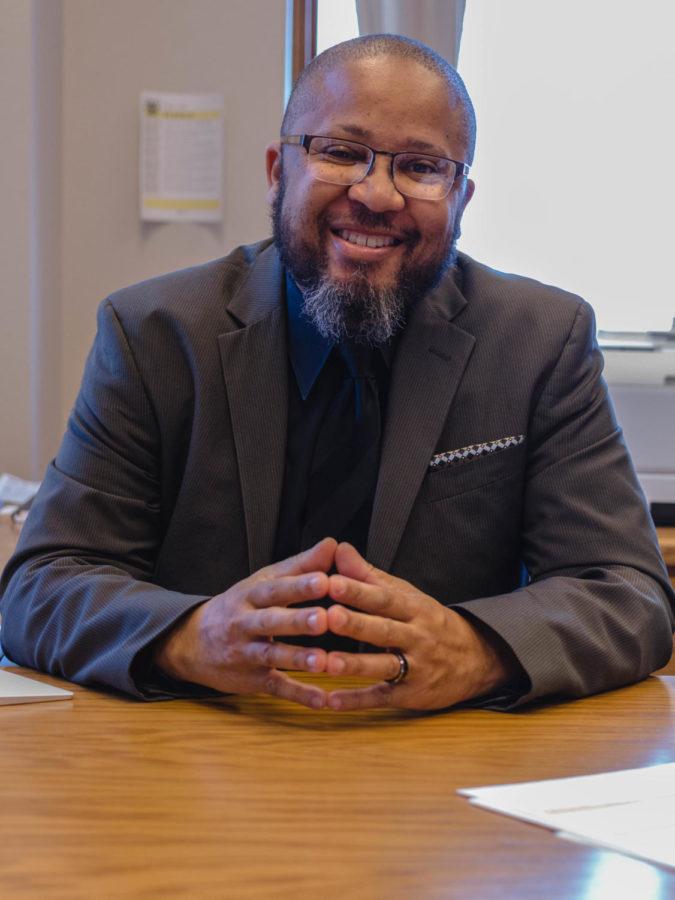The other side to the office of diversity and inclusion
Dr. Reginald Stewart, VP of diversity and inclusion, was hired on Oct. 15, 2015 following a list of needs and recommended solutions from student group Latinos United For a Change.
April 3, 2017
Though the Office of Diversity and Inclusion may be new to Iowa State, having been established in the spring of 2015, faculty in the office are transitioning into roles with familiar responsibilities. Their roles, stresses and expectations are not any different from any other administrative role on campus.
Before being appointed in 2015, Reginald Stewart, vice president for diversity and inclusion, served as the chief diversity officer at the University of Nevada, Reno. Stewart said that it was important for someone in his position to build trust and engage with the Iowa State community.
Nicci Port, project director for diversity and inclusion in LGBTQA+ affairs, agreed with Stewart on the importance of building relationships.
“We’re all navigating the relationship building part,” Port said.
Liz Mendez-Shannon, who was appointed as project director for the office of diversity and inclusion in Hispanic and Latinx affairs in November 2016, saw the role as an opportunity to engage diversity and inclusion in a different way, but also revert back to previous work.
Mendez-Shannon’s experiences in leadership and social work in Harlem, New York, helped her gain authenticity that she believes has helped direct her to her current role.
“I hope to create conversations with diversity and inclusion,” Mendez-Shannon said.
She also said that she tries to be approachable and collaborative in her work. With each of their roles being relatively new, the day-to-day responsibilities have helped each individual adjust to their positions.
Their daily schedules, which include meetings with students and faculty, are intended to build trust and relationships between the administrators and their publics.
“You’re working with the community just as much as the campus,” Stewart said.
Since fall 2015, there have been a number of student demonstrations against public policy and social issues, including a demonstration dubbed Hoodies and Hijabs.
The demonstration saw hundreds of students, faculty and Ames community members march in solidarity. Stewart said he understands the mindset of students who are affected by changes in public policy.
“It’s relatable,” Stewart said. “It doesn’t have to be explained to the people. I refuse to be afraid.”
Mendez-Shannon said that she sees similar social climate not only in her workplace but also in her personal life. Mendez-Shannon, a mother of twin daughters, recalled a conversation between her and her daughters after President Donald Trump’s reddit toward immigration during his campaign for the presidency.
“[President Trump] placed an image on a community,” Mendez-Shannon said.
She also recalled her daughters believing that they weren’t welcomed in a country they called home. They even believed that they would have to leave. Mendez-Shannon said she told her daughters that they had a rightful presence in the United States.
“I can associate with the fear,” Mendez-Shannon said.
Stewart admitted that his career takes a toll on his personal life.
He credited rest and healthy eating habits in helping him to return to work every day.
Port has seen her role in the office of diversity and inclusion opening up conversations within her family.
Port said she has noticed her father becoming more engaging in conversations relating to topics within the LGBTQA+ community due to her work within the community.
“We never, ever explored it as a family before,” Port said.
The administrators agreed that stepping out of the office on occasion has helped them relax.
Each of the administrators has found activities unrelated as a source of relaxation.
Port revealed that her daily commute to work and listening to the radio has brought the most satisfaction to her. Bike riding has become another activity Port likes to do during her free time.
“I think it’s healthy when we step away,” Mendez-Shannon said. “It helps us. It energizes our division.”
Mendez-Shannon also enjoys exercising in her free time.
“I love hot yoga,” Mendez-Shannon said.
Mendez-Shannon’s free time also includes spending time with her twin daughters. She credited her daughters for her self-growth.
Stewart said he used to never took breaks. Now, he has acknowledged the need to do so. He said he enjoys his surroundings.
“My children are interested in what I do,” Stewart said, “but they are more proud that their dad is a vice president.”
For the office of diversity and inclusion, the future is most exciting. Port’s excitement surrounds the upcoming strategic plan for the office and the research involved.
Port sees the research as monumental lessons that she and many can take and learn from.
“I’m excited for the work we’re doing for the strategic plan,” Port said. “There’ll be questions we’ve never asked about.”
Stewart said he is excited to see the future students who decide to attend Iowa State and what they will bring to the university.
Port, Mendez-Shannon and Stewart are excited for the continuation of the three working side by side.
“We charge one another’s batteries,” Stewart said. “That’s an environment you don’t build without a cohesive intentional effort.”
Stewart added that their office is built on a foundation of teamwork.
“There’s elements [to the career] that are hard,” Stewart said. “People make it rewarding.”







